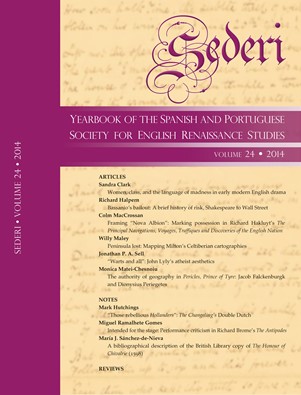“Warts and all”: John Lyly’s atheist aesthetics
Palabras clave:
John Lyly, atomism, aesthetics, Empedocles, Euphues, The Anatomy of Wit, CampaspeResumen
This paper finds some evidence of an atomist aesthetic in certain passages of John Lyly’s Euphues. The Anatomy of Wit. It then addresses the issue of how Lyly might have become acquainted with atomist philosophy and, in particular, the thought of Empedocles, whether through his reading or his membership of the Oxford circle. Finally, by showing how Lyly’s early play Campaspe combines his aesthetic views and atomist controversy, the paper confirms the reasonableness of its initial proposition and opens the way not only for a reassessment of Lyly and his works but also for a reappraisal of the baroque in early modern English literature and for a revision of standard accounts of the origins of English atomism.
Descargas
Descargas
Publicado
Número
Sección
Licencia
The copyright holder of the published contributions is SEDERI.The hardcopy and an open-access version of the journal will be published simultaneously. The issues will be available online in the SEDERI website (http://www.sederi.org/yearbook/) and other repositories that have signed an agreement with SEDERI.
The authors who publish with this journal agree to the following terms:
a) SEDERI retains copyright of the essay.
b) If the author wishes to republish or rewrite the essay for another journal, or include the essay published in SEDERI in their personal repositories, or in any other way, they should contact the editors to obtain permission to do so. This will entail citing SEDERI as the original source and sending the editors a copy of the new version, or the link to the website, in case of online publishing.
The author(s) hereby warrant(s) that:
a) The essay submitted for publication is an original creation and does not infringe any copyright or property right of another journal, author or publisher.
b) The essay submitted for publication has not been previously published, whole or in part, and is not being considered for publication elsewhere.
c) Written permission has been obtained for any material from other sources included in the essay submitted for publication.




